Frequently Asked Questions (FAQs)
This FAQ provides answers to questions about specific ingredients or cooking methods that are featured in these recipes.
Question: What if I can't find certain
ingredients in my supermarket? Can I substitute other ingredients for
them?
 Some recipes have ingredients that may not be available in every
supermarket across the country or may cost more than you want to pay.
Here are some suggestions for alternatives:
Some recipes have ingredients that may not be available in every
supermarket across the country or may cost more than you want to pay.
Here are some suggestions for alternatives:
- Fish sauce: For 1 tablespoon of fish sauce,
use ½ tablespoon anchovy paste (see below), ½ teaspoon soy sauce,
and 1 teaspoon stock or broth.
- Hoisin sauce: For 1 tablespoon Hoisin sauce,
substitute ½ tablespoon lite soy sauce, 1 teaspoon sugar, and ¼
teaspoon ground ginger.
- Mirin: Substitute any sweet white wine or a
generic white wine with a pinch of sugar.
- Rice vinegar: Substitute white wine
vinegar.
- Asian hot chili sauce: Substitute regular
chili sauce.
- Green curry paste: For 1 tablespoon green
curry paste, substitute ½ tablespoon yellow curry powder thinned with
1–2 teaspoons water.
- Ginger root: For 1 tablespoon fresh ginger
root, substitute 1 teaspoon ginger powder. Fresh ginger root also can be
stored in the freezer for up to 1 year and grated as needed.
- Anchovy paste: Use an equal amount of mashed
canned anchovy fillets.
Question: What is the meaning of all the different
product nutrient label claims?
One of the best ways to find heart healthy products is to check the food
labels. Here are some terms to look for per labeled serving to find
products lower in sodium, fat, cholesterol, and calories.
Sodium
- Sodium-free: Less than 5 milligrams (mg)
of sodium per serving
- Very low sodium: 35 mg or less of sodium
per serving
- Low-sodium: 140 mg or less of sodium per
serving
- Low-sodium meal: 140 mg or less of
sodium per 3½ ounces
- Light (or lite) in sodium: At least 50
percent less sodium per serving than the regular version
- Reduced or less sodium: At least 25
percent less sodium per serving than the regular version
- Unsalted or no salt added: No salt added
to the product during processing, but this is not necessarily a sodium-free
food
If you can't find products labeled "low-sodium," compare the
Nutrition Facts panels on available products to find the one with the lowest
amount of sodium.
Cholesterol
- Cholesterol-free: Less than 2 milligrams
(mg) cholesterol and less than 2 grams (g) of saturated fat per serving
- Low cholesterol: 20 mg or less
cholesterol and less than 2 g of saturated fat per serving
- Reduced or less cholesterol: At least 25
percent less cholesterol than the regular version and less than 2 g of
saturated fat per serving
|
Fat
- Fat-free: Less than ½ gram (g) of
fat per serving
- Saturated fat-free: Less than ½ g
of saturated fat and less than ½ g of trans fat per
serving
- Low-saturated fat: 1 g or less of
saturated fat and 15 percent or less calories from saturated fat per
serving
- Low-fat: 3 g or less of fat per
serving
- Reduced fat: At least 25 percent less
fat per serving than the regular version
- Light in fat: Half the fat per serving
(or less) than the regular version
Calories
- Calorie-free: Less than 5 calories per
serving
- Low-calorie: 40 calories or less per
serving
- Low-calorie meal: 120 calories (or less)
per 3½ ounces
- Reduced or less calories: At least 25
percent fewer calories per serving than the regular version
- Light (or lite): Half the fat (or less)
or a third of calories per serving of the regular version
|
|
Source: Food and Drug Administration,
http://www.fda.gov/Food/GuidanceComplianceRegulatoryInformation/ GuidanceDocuments/FoodLabelingNutrition/
FoodLabelingGuide/ucm064911.htm |
Question: How do I cut meat across the grain?
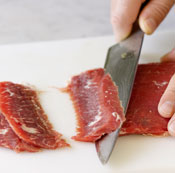 If you have ever wondered what it means to cut
meat "against the grain," here is your answer.
If you have ever wondered what it means to cut
meat "against the grain," here is your answer.
Some cuts of meat have distinct fibers in them, which make the meat
difficult to chew. Flank steak (typically used to make London broil),
skirt steak, and brisket are good examples. Cutting through the fibers or
grain in the meat makes it tender and easier to chew.
The picture at right shows the lines of the steak running from right to
left down the length of the steak. If you slice this steak in the same
direction as those lines, you'll have to chew through the fibers. Whereas
if you cut across the lines or the grain, the knife will have already done that
work before a bite reaches your mouth.
When slicing this type of meat, it is often recommended to slice thinly
at a 45-degree angle, as shown.
Question: How do I zest a lemon or orange?
Zest is the colorful outer rind on a lemon or orange (not the
white pith underneath, which is bitter). There are several ways to grate
citrus peel:
- Use a regular vegetable peeler to make thin, larger slices.
- Use a citrus zester, which has a stainless-steel edge with a series
of sharp-edged holes that cut off thin strips of the peel.
- Use a microplane, or flat grater, which allows you to shred multiple
small strips of peel faster and with less pressure than a regular grater or
citrus zester.
Question: What herbs can be used to substitute for an
herb I don't have on hand?
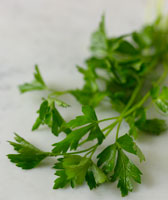 Although each herb has its own unique
flavor, many herbs can be substituted for one another. Here are some
fresh or dried herb alternatives to try:
Although each herb has its own unique
flavor, many herbs can be substituted for one another. Here are some
fresh or dried herb alternatives to try:
- For sage: Try savory, marjoram, or rosemary.
- For basil: Try oregano or thyme.
- For thyme: Try basil, marjoram, oregano, or
savory.
- For mint: Try basil, marjoram, or rosemary.
- For rosemary: Try thyme, tarragon, or savory.
- For cilantro: Try parsley or coriander.
Question: How can I plan ahead for recipes that call for precooked chicken or cooked mixed vegetables?
A few of the dishes call for precooked ingredients. This is a great chance to use leftover ingredients or do some "batch" cooking. Here are two examples:
- The "Fried" Rice and
Chicken recipe suggests using leftover chicken
and sauce from the Hawaiian Huli Huli Chicken recipe. When cooking this dish, refrigerate or freeze immediately any leftover chicken and sauce or make extra specifically to reuse when you make "Fried" Rice and Chicken.
- The Garden Turkey Meatloaf recipe suggests a variety of cooked vegetables, such as mushrooms, zucchini, red peppers, or spinach. You can refrigerate or freeze extra vegetables from previous meals and toss them into the meatloaf, or you can cook vegetables just for this recipe.
The following recipes use cooked chicken or vegetables in the ingredients list, so plan ahead and enjoy them with your family:
If you don’t have leftover ingredients to use in these recipes, see
basic cooking instructions.
Question: What are some simple and healthy meal ideas for using various ingredients in my refrigerator and pantry?
Knowing how to choose a few ingredients from your refrigerator, pantry, or freezer and toss them together for a quick and delicious meal in a hurry is a useful skill. Staple ingredients such as pasta, fresh or frozen vegetables, canned beans, chicken breast, frozen shrimp, and lean ground turkey can help you make a meal in minutes. It takes a bit of creativity, but you don't need to be an experienced chef to do it.
See what you have on hand, and try using the basic cooking instructions and meal preparation tips provided in these recipes. Have your kids join you in the kitchen and make it a family challenge—they may surprise you with some great suggestions!
Quick and Healthy Meal Suggestions
- Toss whole-wheat pasta with broccoli, garlic, canned no-salt-added tomatoes, and white (cannellini) beans. Season with fresh or dried herbs to taste.
- Make an omelet with an assortment of vegetables (such as mushrooms, red peppers, onions, spinach, etc.), and serve with a side of black beans and a small amount of grated cheddar cheese.
- Grill chicken breasts marinated in balsamic vinegar with olive oil. Serve with a spinach salad and brown rice.
- Brown lean ground turkey and mix with low-sodium tomato sauce over whole-wheat pasta. Serve with a green salad and fruit.
- Sauté frozen shrimp with frozen vegetable stir-fry, minced garlic, ginger, and lite soy sauce. Serve with brown rice or soba (buckwheat noodles).
- Make a salad with tuna (use water-packed tuna and drain it first), sliced cucumber, black olives, crumbled feta cheese, and a small amount of reduced-calorie vinaigrette.
Serve with a side of whole-wheat pita bread.
Question: How do I take the skin off a freshly roasted red pepper?
 First—to roast them—place red peppers on a nonstick baking sheet under a broiler for about 10 minutes or until the skin is blackened. Once the pepper is blackened, place it in a plastic bag or bowl wrapped with plastic, and let it rest for 5 minutes. Scrape off the burnt skin and rinse the pepper under cool water. Slice according to recipe instructions.
First—to roast them—place red peppers on a nonstick baking sheet under a broiler for about 10 minutes or until the skin is blackened. Once the pepper is blackened, place it in a plastic bag or bowl wrapped with plastic, and let it rest for 5 minutes. Scrape off the burnt skin and rinse the pepper under cool water. Slice according to recipe instructions.
Note: Make and freeze extra roasted peppers to use in
Super Quick Chunky Tomato Sauce,
Tangy Salsa,
Zesty Tomato Soup, and
Roasted Red Pepper and Toasted Orzo.
Question: How do I choose and slice an avocado?
Avocados are used in both
Quinoa-Stuffed Tomatoes and
Tuna and Avocado Cobb Salad.
Here are tips on choosing, ripening, and slicing an avocado.
Choosing an Avocado
The best way to tell whether an avocado is ready for immediate use is to gently squeeze the fruit in the palm of your hand.
Ripe, ready-to-eat avocados will be firm yet will yield to gentle pressure.
Ripening an Avocado
To ripen an avocado, place the fruit in a plain brown paper bag and store at room temperature (65–75 °F) until ready to eat (usually 2–5 days).
Adding an apple or banana in the bag speeds up the process, because these fruits give off a gas that helps ripen other fruit.
Peeling and Slicing an Avocado
- Start with a ripe avocado that is rinsed and dried.
- Cut it in half lengthwise around the pit. Twist the halves to separate.
- Tap pit gently with a knife. Remove the pit by sliding the tip of a spoon gently underneath and lifting it out.
- Peel the avocado by placing the cut side down and carefully removing the skin with a knife or your fingers, starting at the small end.
Or simply scoop out the avocado meat with a spoon.
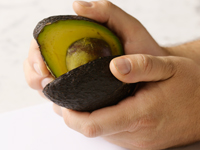 |
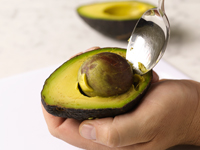 |
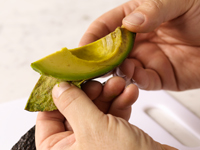 |
Cut and twist
|
Spoon out pit
|
Peel
|
Question: How do I "fold in" a whipped egg to batter?
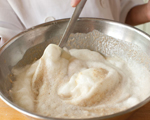 "Folding" eggs into batter is a technique used to create extra fluffy cakes and waffles. This technique is used in Oatmeal Pecan Waffles (or Pancakes).
See picture for how to whip the eggs and "fold" them into the batter.
"Folding" eggs into batter is a technique used to create extra fluffy cakes and waffles. This technique is used in Oatmeal Pecan Waffles (or Pancakes).
See picture for how to whip the eggs and "fold" them into the batter.
Question: How do I use phyllo dough to wrap eggrolls?
Phyllo dough sheets are very delicate, and it's important to keep the dough moist with a clean damp towel while preparing it. Phyllo dough is used in Baked Eggrolls.
See pictures below for how to keep phyllo dough moist and how to fold the eggroll.
_______________
™Keep the Beat is a trademark of the U.S. Department of Health and Human Services.

Live Chat external link
Get Email Alerts




